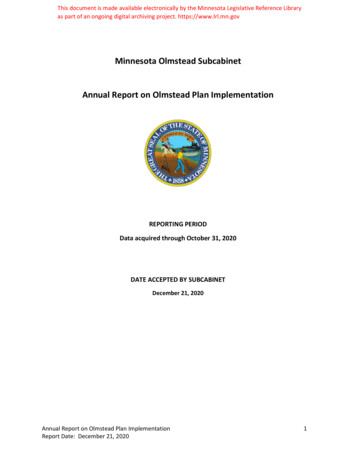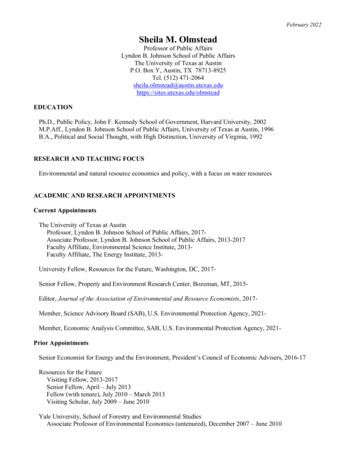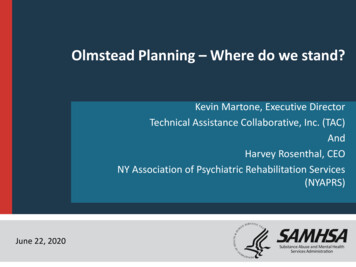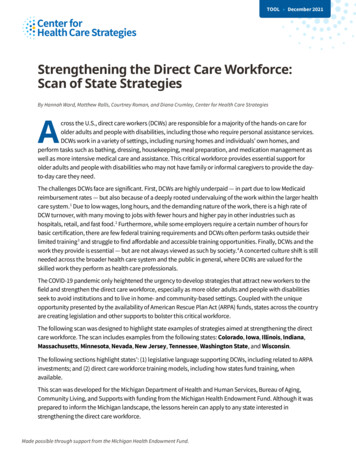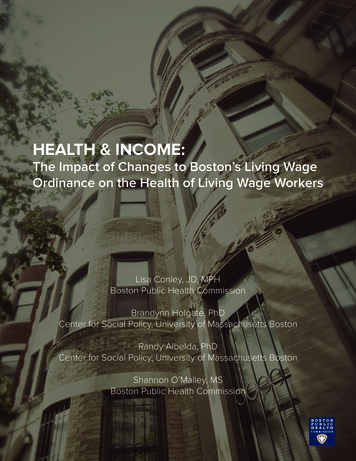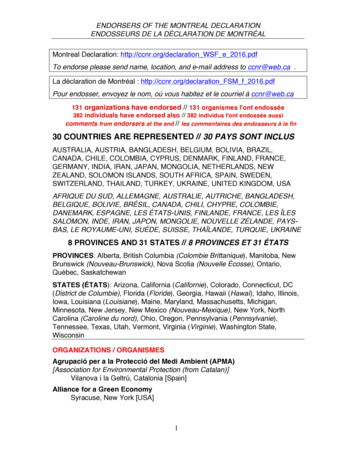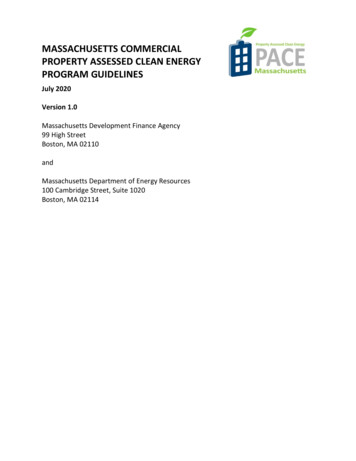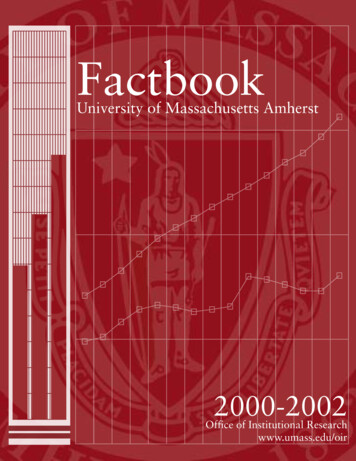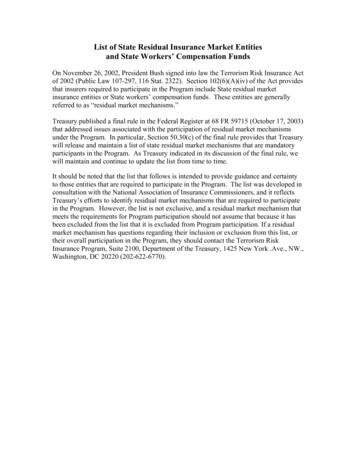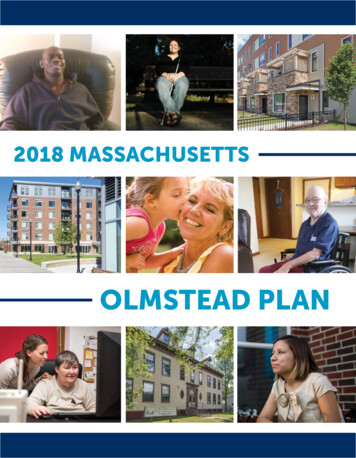
Transcription
2018 MASSACHUSETTSOLMSTEAD PLAN
Cover images of properties courtesy of Community Economic Development Assistance Corporation.
Table of ContentsI. Introduction . 2II. Highlighted Progress from 2008 to 2017 . 6Transitioning Individuals with Disabilities to Community-Based Settings .6Diverting Individuals from Unnecessary Institutional Placements .6Investments in Affordable Housing and Community-Based Long-Term Services and Supports .8Community-Integrated Employment and Workforce Development Supports .12Investment in Accessible Transportation Infrastructure & Services for Individuals w/Disabilities . 13III. Olmstead Planning Process and Structure . 15Draft Plan Public Review and Comment . 16IV. Goals for Continued Progress . 17GOAL 1: Expanding Access to Affordable, Accessible Housing with Supports . 19GOAL 2: Enhancing Community-Based Long-Term Services and Supports . 24GOAL 3: Promoting Community-Integrated Employment of People with Disabilities . 29GOAL 4: Investing in Accessible Transportation for Individuals with Disabilities . 30V. Conclusion . 31Infrastructure to Support Plan Implementation . 31Plan Implementation, Ongoing Review, and Updating . 31Appendix A. Community First Plan . 32Brief description of the 2008 Community First Olmstead Plan. 32Goals and Principles . 32Appendix B. Additional Progress Between 2008 to 2017 . 33Transitioning and Diverting Individuals from Institutional Placement . 33Expanding Access to Affordable, Accessible Housing . 34Community-Based Long-Term Services and Supports. 35Promoting Community-Integrated Employment of People with Disabilities . 37Investment in Accessible Transportation Infrastructure & Services for Individuals w/ Disabilities . 39Appendix C: List of Olmstead Advisory Council Members . 41Appendix D: Olmstead Planning Committee . 43Appendix E: Olmstead Accountability Benchmark Document. 44Appendix F. Glossary of Terms . 701
I.IntroductionIt is the policy of the Commonwealth of Massachusetts (Massachusetts, the Commonwealth, or the state)to facilitate opportunities for all people with disabilities to live their lives fully included and integrated intotheir chosen communities – both by increasing the movement of such persons from institutional tocommunity settings and by preventing the unnecessary institutionalization or homelessness of suchpersons. People with disabilities should have access to accessible, flexible, robust, and quality systems ofcommunity-based housing and home-and-community-based long-term services and supports that,working in tandem, support their ability to live, work, and be served in their chosen communities.Like many other states, the Commonwealth has memorialized, in what is known as an “Olmstead Plan,”its commitment to promote opportunities for persons with disabilities to live, work, and be served incommunity-based settings. The Commonwealth released its first Olmstead Plan in 2008. This updatedOlmstead Plan tracks the progress that the Commonwealth has made towards achieving the 2008Olmstead Plan’s goals and other Olmstead-related goals and sets forth the Commonwealth’s plan forcontinuing to build upon that progress.The term “Olmstead Plan” derives from the Supreme Court’s opinion in Olmstead v. L.C., 527 U.S. 581(1999), in which the Court held that the Americans with Disabilities Act, as well as the regulationspromulgated under that statute, prohibit the unjustified institutional isolation of individuals withdisabilities. Specifically, the Court concluded that public entities must provide community-based services– as opposed to institutionally-based services – to persons with disabilities when:1. The public entity’s treatment professionals determine that community-based placement isappropriate;2. The affected persons do not oppose such treatment; and3. The placement can be reasonably accommodated, taking into account the resources available tothe public entity and the needs of others with disabilities.The court also signaled that public entities should develop “a comprehensive, effective working plan forplacing qualified persons with disabilities in less restrictive settings.” As a result, the Commonwealthreleased its first Olmstead Plan in 2008. That plan promoted choice and opportunity for individuals withdisabilities, and established goals for the development of more accessible and effective long-term supportin local communities. To that end, the plan supported a shift of state support for long-term care frominstitutions to the community.1Nearly ten years have passed since the Commonwealth released its 2008 plan. The Commonwealth isissuing this update to memorialize its progress over the last decade and to identify opportunities forcontinued progress. Through an extensive yearlong planning process that included engagement betweenrelevant state agencies and providers, advocates, consumers, and other interested stakeholders,2 theCommonwealth developed a plan that builds upon, strengthens, and broadens the foundation establishedPlease see Appendix A for more information about the 2008 Plan.Recognizing the large number of groups interested in the development of the updated Olmstead plan, theCommonwealth developed and administered a multi-faceted stakeholder engagement strategy that included theappointment of an Olmstead Advisory Council, four public community-based Listening Sessions, as well as an OlmsteadPlan webpage to gain input from stakeholders. The plan devotes considerable attention to those areas identified bystakeholders as essential to ensuring that individuals with disabilities have the opportunity to live, work, and be served intheir communities.122
by the 2008 plan. While the 2008 plan was developed by EOHHS agencies with a primary focus on EOHHSprograms, the development of the 2018 plan included active participation from those service-orientedagencies as well as state housing agencies, stakeholders from the affordable housing community, theExecutive Office of Labor and Workforce Development, and the Massachusetts Department ofTransportation (MassDOT). Thus, the updated plan continues many of the service-oriented initiatives setforth in the 2008 plan and provides heightened focus on the roles of affordable and accessible housing,workforce development, and transportation in providing people with disabilities the opportunity to liveand work in their communities.As a result, the plan takes an expansive view of the various interrelated obstacles that may limit the abilityof individuals with disabilities to remain within the community, such as needs for services, housing,employment, and transportation. With the 2018 Olmstead Plan, the Commonwealth has attempted toconstruct a comprehensive and responsive system of services and supports that allow people withdisabilities to live, work, and be served in integrated and community settings that are appropriate for theirneeds.The plan continues the Commonwealth’s long-standing efforts to develop and promote new systems,procedures, and funding to allow for effective and sustainable diversionary pathways for people withdisabilities.For example, Massachusetts has been at the forefront of collaborations and partnerships across multipleagencies that provide services and supports – health, transportation, employment, supportive housing,and others – to meet the needs of people with disabilities. A few examples of these collaborations haveincluded: Under the state’s five-year innovative 1115 Medicaid waiver, MassHealth will receive 1.8 billionin new federal investments to restructure the current MassHealth system. A major component ofthis funding will be community-based health care and human service organizations who willpartner with the ACOs to integrate and improve the health outcomes of approximately 60,000MassHealth members with complex long-term medical and/or behavioral health needs. Underthe Community Partner model, 145 million over five years will be made available to CommunityBased Long-Term Services and Supports (LTSS) organizations providing care coordination supportfor people with complex long-term services and support needs. This includes members withphysical disabilities, traumatic brain injury, intellectual or developmental disabilities, and others. The Options Counseling program, a collaboration among the Executive Office of Elder Affairs(EOEA), MassHealth, Massachusetts Rehabilitation Commission (MRC), and a statewideconsortium of partners, was designed to provide counseling and decision support to individualsat risk of nursing facility admission about the availability of community-based long-term servicesand supports in order to divert those individuals from unnecessary nursing facility admission. MassHealth sought and obtained approval from the federal government to provide an array ofcommunity-based services and supports for MassHealth members who are in, or meet level ofcare criteria for, nursing facilities, rehabilitation hospitals, or interim care facilities fordevelopmental disabilities, and who want to live in the community. These waivers areadministered in partnership with the EOEA, the MRC, and the Department of DevelopmentalServices (DDS).3
EOHHS and MassDOT have jointly supported MassMobility, an initiative promoting mobilitymanagement and transportation coordination statewide. Housed in EOHHS, MassMobility worksclosely with MassDOT to promote existing transportation services and provide technicalassistance to state agencies and partner organizations looking to expand mobility for people withdisabilities and other consumers. MassMobility was developed in direct response to theCommonwealth’s recognition of the connection between accessible transportation and access tohealth services, employment, and community participation for persons with disabilities. With the Supportive Housing Program, the Executive Office of Elder Affairs and the Departmentof Housing and Community Development (DHCD) have collaborated to facilitate partnershipsbetween Local Housing Authorities (LHAs) operating state-funded public housing for the elderlyand local service agencies to provide service-rich environments to support these residents. Thisinitiative will help allow current and future public housing residents to age in their community. Massachusetts was among the first states in the nation to create a program funded throughMassHealth/Medicaid to provide housing search, transition support, and housing stabilizationservices to chronically homeless persons with disabilities.Throughout the planning process, the Commonwealth has been committed to developing acomprehensive, holistic, and innovative plan that builds upon the past and takes into account all of theneeds of, and challenges facing, individuals with disabilities. In keeping with this vision, theCommonwealth has structured this 2018 Plan around four key Olmstead-related goals, ensuring that eachof the specific initiatives that form the core of this 2018 Plan furthers at least one of these goals.The four key goals are:1. Expanding Access to Affordable, Accessible Housing with SupportsAffordable, accessible housing is one of the key elements necessary to help people withdisabilities transition to and remain in the community. In 2018, an individual with a disability inMassachusetts whose sole source of income is Supplemental Security Income (SSI) has a monthlyincome of 864 ( 878 if elderly), including the federal benefit of 750 and a state supplementalpayment. The 2018 average rents in Massachusetts for a one-bedroom or even an efficiency unit– 1,204 and 1,065, respectively – are well above the entire SSI benefit.2. Enhancing Community-Based Long-Term Services and SupportsAccess to a broad range of community-based services is critical to many people with disabilitiescoming from an institution or at risk of institutionalization. Individualized supports should bereadily accessible and provided only on a voluntary basis. In addition to medical, mental health,substance use, personal care, and other services to meet individual needs, access to supports thatcan help individuals maintain a successful tenancy are critical.4
3. Promoting Community-Integrated Employment of People with DisabilitiesResearch suggests most people with disabilities would prefer to work 3. Employment providesfinancial, social, and personal rewards. Providing people with disabilities with competitiveemployment opportunities as well as any needed supports to take advantages of theseopportunities is key.4. Investing in Accessible Transportation for Individuals with DisabilitiesMany people with disabilities do not drive or own a personal automobile. A disability may makesecuring a license or having enough funds to purchase a car and cover the ongoing costs ofinsurance and gasoline difficult or impossible. Thus, many people with disabilities are reliant onlocal or regional public transportation systems to get to their grocery store, bank, medicalappointments, social engagements, volunteer, and competitive work.Through this updated plan, the Commonwealth will continue to fulfill the promise of Olmstead, facilitatingopportunities for people with disabilities to live their lives fully included and integrated into their chosencommunities.****Part II of this Plan tracks the Commonwealth’s progress toward meeting the goals set forth in the 2008Plan, as well as other Olmstead-related goals. Part III provides a summary of the plan developmentprocess. Part IV identifies goals for continued progress – the specific initiatives that form the heart of this2018 Plan. Finally, Part V concludes with an overview of the Commonwealth’s plan implementationstrategy, including the Commonwealth’s commitment to continuously review and monitor its progresstowards achieving the goals set forth in this plan.Embracing the Commonwealth’s intention for the Olmstead Plan to be a living plan rather than a staticdocument, we anticipate that goals and strategies will need to be adjusted and refined as implementationproceeds or circumstances warrant.2015 Kessler Foundation National Employment & Disability Survey: Overview. Retrieved July 12, 2018 fromhttps://kesslerfoundation.org/kfsurvey15.35
II. Highlighted Progress from 2008 to 2017Massachusetts has made significant progress towards meeting the goals it set forth in its initial 2008Olmstead Plan, as well as other Olmstead-related goals. The following are some of the Commonwealth’skey achievements in transitioning and diverting individuals with disabilities from institutions into thecommunity.Transitioning Individuals with Disabilities to Community-Based Settings MassHealth, Massachusetts’ Medicaid Program, applied for and was awarded a Money Followsthe Person (MFP) Demonstration grant from the Centers for Medicaid and Medicare Services(CMS) in 2011. The Commonwealth and its contractors, ASAPs, and Independent Living Centers(ILCs), have transitioned over 2,150 people to community-based settings. Over half of theindividuals transitioned were people with disabilities, who had resided long-term in nursingfacilities and other long-stay facilities. Massachusetts applied for and was awarded a federal Balancing Incentive Payment Program (BIP)grant to promote rebalancing of the ratio of state spending on community-based long-termsupport services (LTSS) versus facility-based LTSS. Over the period of the grant, theCommonwealth increased its ratio of spending on community-based LTSS from 44.8 percent in2009 to 70 percent in 2016. In October 2008, DDS4 developed a community services expansion and facilities restructuring planto expand the residential services available in the DDS community system and to reconfigure theDepartment’s state facilities by placing individuals who had been served in state facilities into thecommunity, when appropriate. At the time there were 476 residents at the Fernald, Monson,Glavin, and Templeton facilities. Since 2008, all of these facilities have closed, and their residentswere transitioned to the community. DDS engages with individuals and families residing at Wrentham Developmental Center (WDC)and Hogan Regional Center (Hogan) who are interested in moving into the community. The mostrecent WDC census of 261 (June 2018) includes 11 who were admissions from the MarquardtNursing Facility which closed in 2017. The census at Hogan is currently 106 (August 2018). DDSwill provide quarterly updates for both Hogan and Wrentham as part of the outcome measuresfor the revised Olmstead Plan.Diverting Individuals from Unnecessary Institutional Placements4 The Options Counseling (OC) program has served over 33,000 elders and people with disabilitiessince it was first piloted in 2008. Among other things, the OC program provides individuals at riskof nursing facility admission with counseling and decision-support regarding the availability ofcommunity-based long-term services and supports. The Department of Mental Health (DMH) has supported the provision of Mental Health First Aidand Crisis Intervention Team (CIT) training to law enforcement personnel in more than 100communities across Massachusetts, training 629 officers during Fiscal Year 2017. Trained lawIn 2008 DDS was the Department of Mental Retardation (DMR).6
enforcement personnel responded to over 5,000 incidents5 and behavioral health crises duringthis same time; more than 4,000 of these were non-criminal incidents involving psychiatricsituations, follow-ups, wellness checks, and general disturbance calls. When CIT trained officersresponded to situations where persons could have been criminally charged and diversion was anoption, criminal charges were diverted over 85 percent of the time.He “accepts the challenge and will win.”In his early 50s, Deric entered a nursing facility after having a stroke. After two years, he wasable to walk some distance using a cane but used a wheelchair much of the time. He was readyto return to the community, but he had no housing. While still in the facility, he met one of theMoney Follows the Person Demonstration Program’s staff. She enrolled Deric in theDemonstration and started working to identify housing that would meet Deric’s accessibilityneeds. She assisted Deric in applying for housing vouchers and applications for manyapartments in the Boston area, but they had difficulty finding an accessible, affordable unit.After several years, he found an accessible apartment with affordable rent funded through the811 Project Rental Assistance (PRA) program.Deric was nervous about returning to the community after having had total support in thenursing facility for five years, but he is excited to be on his own. He is happy to have morefreedom, privacy and the opportunity to cook again. He “accepts the challenge and will win.”Preventing and Ending HomelessnessWhile not explicitly a part of the 2008 Olmstead Plan, in recent years Massachusetts has determined thataddressing chronic homelessness is an integral aspect of its effort to prevent unnecessary institutionalplacements of individuals with disabilities. MassHealth developed and implemented the Community Support Program for PeopleExperiencing Chronic Homelessness (CSPECH), a nationally-recognized program that assistsMassHealth members enrolled in the Massachusetts Behavioral Health Partnership (MBHP) whoare experiencing chronic homelessness to secure and maintain supportive housing. From 2011 to 2016, the Commonwealth reduced the number of homeless6 Veterans by 25percent; functionally ended homelessness among Veterans in the cities of Lowell and Lynn as wellas in those communities that make up the “Balance of State” Continuum of Care (CoC) operatedby DHCD to address service gaps in all Massachusetts cities and towns not served by another CoC;and ended chronic Veterans’ homelessness in the city of Boston.Incident refers to any police encounter with an individual either as a response to a call for service or encounters initiatedby police themselves while on patrol.5Data is not available as to the proportion of these homeless Veterans who qualify as people with disabilities. However,the National Coalition for Homeless Veterans estimates that more than half of homeless Veterans are people withdisabilities, with 50% suffering serious mental illness and 70% struggling with substance use disorders.67
In 2016, the DHCD, MassHousing, and EOHHS agencies invested nearly 500,000 in the TenancyPreservation Program (TPP) to fund an innovative upstream eviction prevention strategy in fivehigh-need areas across the Commonwealth. Over approximately two years this new initiative hasassisted 187 households of families and individuals with disabilities and prevented homelessnessin 95 out of 100 closed cases. Through the Pay for Success Program, DHCD made 140 housing vouchers available for chronicallyhomeless people with disabilities. DHCD’s financial support through rental vouchers comprisedpart of a multi-agency initiative designed to shift public and private resources from institutionalto community-based care. As of June 2018, 18 participating agencies working with the Pay forSuccess Program had collectively housed 710 people statewide with a 92 percent tenancyretention rate, clearly establishing that chronically homeless individuals with a disability can liveoutside of an institutionalized setting.Investments in Affordable Housing and Community-Based Long-Term Services andSupportsThe progress that Massachusetts has achieved in transitioning and diverting individuals with disabilitiesfrom institutional settings has required significant state investment in two areas: affordable housing andcommunity-based long-term services and supports.Expanding Access to Affordable, Accessible Housing 7Massachusetts recognizes that a robust system of affordable, accessible housing is essential to helpingindividuals with disabilities transition to, and remain in, the community. To this end, Massachusetts hasmade significant investments over the last eight years in housing targeted to people with disabilities,including supportive housing (SH) and permanent supportive housing (PSH) 8. These investments includecapital investments, such as grants and deferred payment loans, to make a housing development moreaffordable as well as accessible. These investments also include ongoing rental and operating assistancepayments to owners to make rents affordabl
Olmstead Plan tracks the progress that the Commonwealth has made towards achieving the 2008 Olmstead Plans goals and other Olmstead-related goals and sets forth the ommonwealths plan for continuing to build upon that progress. The term Olmstead Plan derives from the Supreme ourts opinion in Olmstead v. L.C., 527 U.S. 581

